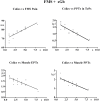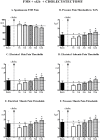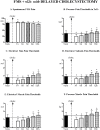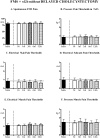Laparoscopic Cholecystectomy for Gallbladder Calculosis in Fibromyalgia Patients: Impact on Musculoskeletal Pain, Somatic Hyperalgesia and Central Sensitization
- PMID: 27081848
- PMCID: PMC4833355
- DOI: 10.1371/journal.pone.0153408
Laparoscopic Cholecystectomy for Gallbladder Calculosis in Fibromyalgia Patients: Impact on Musculoskeletal Pain, Somatic Hyperalgesia and Central Sensitization
Abstract
Fibromyalgia, a chronic syndrome of diffuse musculoskeletal pain and somatic hyperalgesia from central sensitization, is very often comorbid with visceral pain conditions. In fibromyalgia patients with gallbladder calculosis, this study assessed the short and long-term impact of laparoscopic cholecystectomy on fibromyalgia pain symptoms. Fibromyalgia pain (VAS scale) and pain thresholds in tender points and control areas (skin, subcutis and muscle) were evaluated 1week before (basis) and 1week, 1,3,6 and 12months after laparoscopic cholecystectomy in fibromyalgia patients with symptomatic calculosis (n = 31) vs calculosis patients without fibromyalgia (n. 26) and at comparable time points in fibromyalgia patients not undergoing cholecystectomy, with symptomatic (n = 27) and asymptomatic (n = 28) calculosis, and no calculosis (n = 30). At basis, fibromyalgia+symptomatic calculosis patients presented a significant linear correlation between the number of previously experienced biliary colics and fibromyalgia pain (direct) and muscle thresholds (inverse)(p<0.0001). After cholecystectomy, fibromyalgia pain significantly increased and all thresholds significantly decreased at 1week and 1month (1-way ANOVA, p<0.01-p<0.001), the decrease in muscle thresholds correlating linearly with the peak postoperative pain at surgery site (p<0.003-p<0.0001). Fibromyalgia pain and thresholds returned to preoperative values at 3months, then pain significantly decreased and thresholds significantly increased at 6 and 12months (p<0.05-p<0.0001). Over the same 12-month period: in non-fibromyalgia patients undergoing cholecystectomy thresholds did not change; in all other fibromyalgia groups not undergoing cholecystectomy fibromyalgia pain and thresholds remained stable, except in fibromyalgia+symptomatic calculosis at 12months when pain significantly increased and muscle thresholds significantly decreased (p<0.05-p<0.0001). The results of the study show that biliary colics from gallbladder calculosis represent an exacerbating factor for fibromyalgia symptoms and that laparoscopic cholecystectomy produces only a transitory worsening of these symptoms, largely compensated by the long-term improvement/desensitization due to gallbladder removal. This study provides new insights into the role of visceral pain comorbidities and the effects of their treatment on fibromyalgia pain/hypersensitivity.
Conflict of interest statement
Figures













References
-
- Wolfe F, Smythe HA, Yunus MB, Bennett RM, Bombardier C, Goldenberg DL, et al. The American College of Rheumatology 1990 criteria for the classification of fibromyalgia. Report of the multicenter criteria committee. Arthritis Rheum. 1990;33:160–172 - PubMed
-
- Wolfe F, Clauw DJ, Fitzcharles MA, Goldenberg DL, Katz RS, Mease P, et al. The American College of Rheumatology preliminary diagnostic criteria for fibromyalgia and measurement of symptom severity. Arthritis Care Res (Hoboken). 2010;62:600–610 - PubMed
-
- Caldarella MP, Giamberardino MA, Sacco F, Affaitati G, Milano A, Lerza R, et al. Sensitivity disturbances in patients with irritable bowel syndrome and fibromyalgia. Am J Gastroenterol. 2006;101(12):2782–2789 - PubMed
MeSH terms
LinkOut - more resources
Full Text Sources
Other Literature Sources
Medical

